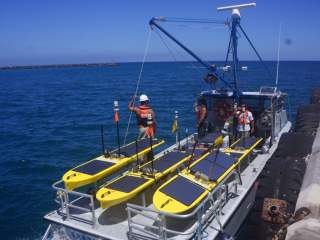The Pentagon's Master Plan to Crack into Silicon Valley
Should the DoD relocate some contracting officials to Sand Hill Road?
On Tuesday evening, as part of the Council’s Captains of Industry series, our Lund Fellow Steve Grundman hosted a panel discussion amongst the CEOs of three Californian startup firms. Mylea Charvat's Savonix is building a “mobile, clinically valid, reliable, neuro-cognitive assessment and brain health platform.” John De Santis’s Hytrust is writing and deploying software that automatically monitors and secures computing infrastructure for “continuous compliance.” Gary Gysin's Liquid Robotics is “instrumenting the ocean” with its fleet of Wave Gliders, solar- and wave-powered robots that track everything from whales to submarines. All three want to help, but have had their frustrations with the government. And all three agreed that the government has a ways to go in convincing the startup community that it’s serious.
The want for fresh ideas from new sources has been a consistent message during Pentagon officials’ periodic pilgrimages west. Last week, the Building went further, asking the Congress to consider, in its final writing of the 2017 National Defense Authorization Act (NDAA), actual set-asides for newcomers. The program would offer contracts for as long as two years, twenty of up to $2 million, and five of up to $5 million, to “companies who have done little or no business with the federal government, but can provide needed innovation.” Those aren’t the monies that get new bombers or missile cruisers built, or even designed. But they are rather like the engineering funding that CIA venture outfit In-Q-Tel has long been providing. And as our panelists agreed, they're the kind of monies that can get startups interested in work with a military purpose.
The Congress, however, is not yet fully impressed. Defense Secretary Carter is, of course, most enthused about his new outpost in Silicon Valley—the “Defense Innovation Unit Experimental” (DIUx). While the nascent office has started small, the Pentagon’s budget submission now requests about $30 million in annual RDT&E funding for the DIUx in fiscal years 2017 through 2021. But in its writing of the 2017 NDAA, the House Armed Services Committee expressed concern “that outreach is proceeding without sufficient attention being paid to breaking down the barriers that have traditionally prevented nontraditional contractors from supporting defense needs, like lengthy contracting processes and the inability to transition technologies.” Under that bill, the DIUx would get nothing and like it until the secretary submits yet another report.
The HASC’s rather weak remedy does illustrate how the government can’t simply legislate change. Our panelists similarly stressed that the Pentagon needs more than an outpost, pointing the way to Washington, advertising that the Defense Department is open for business. No matter how many whiteboards and beanbag chairs the military’s people bring, their “lengthy contracting processes” will continue to discourage entrepreneurs and financiers who can find faster, higher returns for their troubles. As one discussant at our subsequent dinner argued, speeding the contracting isn’t a training issue, but a cultural one. The dense rulebooks actually offer considerable flexibility in contracting already, but the layers of acquisition bureaucracy have encouraged legions of veto players who search those books for ways to say no. That sort of thinking is simply anathema in Silicon Valley, and it can’t be cleared away by inserting language in a bill.
It's also rejected at the Special Operations Research, Development and Acquisition Center (SORDAC) in Tampa, even without any special authorities in law or regulation. As Hondo Geurts told us back in January, he has been working there to acculturate a team that can say yes. Proximity to the leaders they support makes that easier, as the materiel managers can draw their inspiration from people who actually need to operate “at the speed of SOF.” In this way, there’s a reason that the US Air Force runs so much electronics work out of Hanscom Field, alongside Route 128. There’s a reason that the Army Research Laboratory is situated in Durham. The Army’s Tank and Automotive Command is also most logically at the Detroit Arsenal. If you want to buy trucks, set up shop where the trucks are designed and built.
Silicon Valley is the leading example of this dynamic globally. The unique mixing of financial, legal, marketing and engineering talent in commercial clusters propels what the people there can achieve. So could the Defense Department benefit by relocating some contracting officials to Sand Hill Road? Real estate sticker shock aside, our panelists were unconvinced that was necessary. But place matters in business, and the DIUx still feels a bit out of place.
James Hasík is a senior fellow at the Brent Scowcroft Center on International Security. He notes that our recent event was undertaken at the recommendation of Ambassador Bob Gelbard, a board director of the Council. This article first appeared in the Defense Industrialist.
Image: Liquid Robotics.

